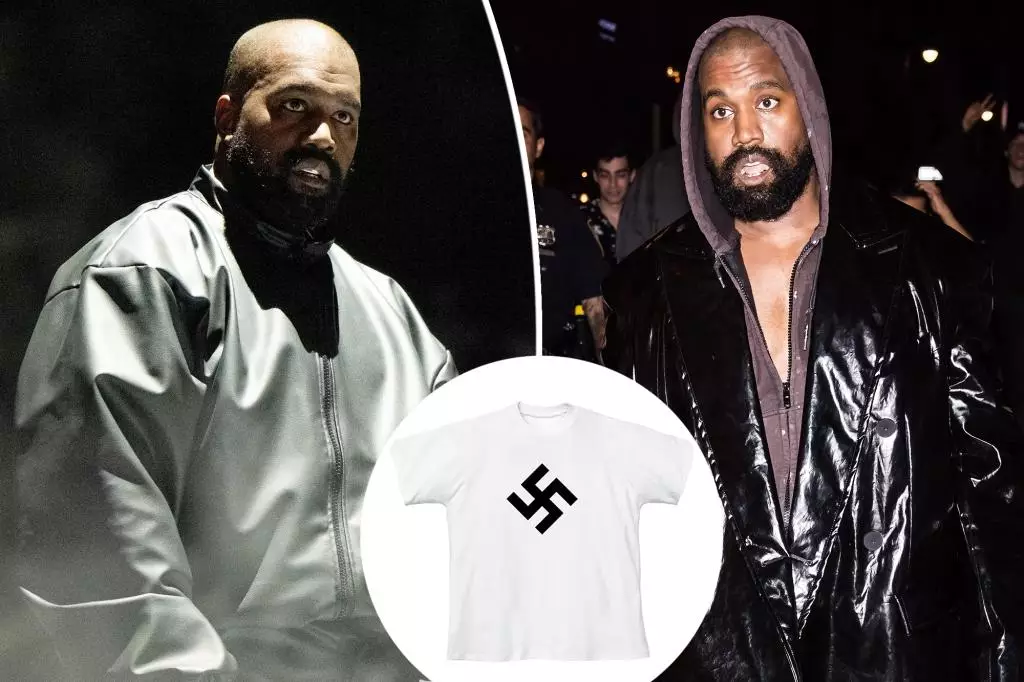Kanye West, who now legally goes by the name Ye, has once again thrust himself into the spotlight, but not for reasons that many would consider constructive. His decision to air a Super Bowl advertisement promoting a T-shirt adorned with a swastika has sparked outrage, igniting discussions on the implications of celebrity, art, and hate symbolism. The shirt, dubbed “HH-01,” was priced at $20 and touted as a long-desired item by Ye, claiming it to be his “greatest performance art piece.” However, this promotion operates in a larger context, challenging societal values and the responsibility that comes with influence.
The swastika, historically recognized as a symbol of hate and oppression, has been co-opted by various movements throughout history, specifically by the Nazis under Adolf Hitler. Ye’s choice to feature this emblem on a piece of clothing raises significant questions about the boundaries of artistic expression and the potential for glorification of hateful ideologies. The Anti-Defamation League (ADL) swiftly condemned the advertisement, highlighting the disturbing nature of merging fashion with something that carries so much historical trauma. When such powerful symbolism is exploited for commercial gain, it trivializes the experiences of those hurt by such narratives.
Ye’s advertisement aired in select markets including Los Angeles, Philadelphia, and Atlanta, and was seemingly approved by Fox based on a concept that did not include the swastika at the time of evaluation. This detail raises ethical dimensions regarding media responsibility. To what extent should broadcasting companies scrutinize content for potential societal harm, especially when it involves public figures with substantial platforms? The fact that Ye’s advertisement reached the audience of the Super Bowl, one of the most-watched events in America, only amplifies the controversy surrounding the message being promoted.
In the foreground of this controversy is Ye’s undeniable influence as a celebrity. With millions of followers across various platforms, his proclamations can resonate with a vast audience, shaping public perception and potentially endorsing extreme ideologies. This power becomes exponentially problematic when combined with a historical context of hate speech, as seen through Ye’s previous antisemitic comments, including declarations of admiration for Hitler. The ADL’s statement condemning Ye for propagating antisemitism during a major event speaks to a growing concern regarding the responsibilities of public figures in the digital age.
Furthermore, the context of Ye promoting a product glorifying hate while making extreme statements about personal relationships — particularly about having “dominion” over his wife — illustrates a troubling dissonance within his narrative. This intersection of personal and public rhetoric contributes to a disturbing blend of misogyny and bigotry, reflecting broader societal issues.
Ye considers himself an artist, and his approach often deliberately provokes thought and controversy. However, the line between artistic expression and societal responsibility is contentious. In his attempts to create art that challenges norms, he has used symbols and language that many see as unacceptable. The notion of deriving artistic merit from a symbol associated with genocide fundamentally clashes with the values of inclusion and respect for human dignity.
Critics argue that within the realm of creative expression, artists must balance their provocative intentions against potential backlash. Thus, Ye’s assertion that the T-shirt is his “greatest performance art piece” can be viewed as an attempt to rationalize behaviors that many perceive as regressive. While artistic expression must be protected, it is equally vital to acknowledge the impact of that art on audiences and society.
Kanye West’s Super Bowl advertisement serves as a critical flashpoint within ongoing dialogues about hate, art, and the responsibilities of influence. As individuals and communities come to terms with the implications of his actions, it is imperative to reflect on the broader messages being conveyed and the responsibilities that come with celebrity status. In a polarized world, where symbols and rhetoric can incite division or understanding, the interaction of art and the ethical considerations surrounding it must be navigated with care. Ye’s recent endeavor highlights an urgent need for clarity in the battle against hate, emphasizing that certain boundaries should never be crossed, even in the name of art.


Leave a Reply